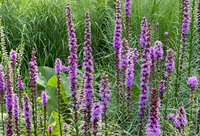
Pain Killers and Wound Healers

Mastering the secrets of herbal medicine was a demanding craft in the olden days, and one which required many years of study.
Healers often had to rely on their instincts, along with the wisdom passed down by their teachers and empirical observations, in order to perfect the art and science of herbal healing.
In the absence of modern pharmacology, the green world was the only solace from pain and injury, and I want to recognize its contribution by listing the most commonly used medicinal plants.
Plants like willow, feverfew, cloves, Boswellia, Devil's claw, cannabis, and poppy were used to relieve pain.
Mullein, violets, arnica, Saint John's Wort, comfrey, jewelweed, cattails, and boneset, helped mend wounds, rashes, burns, bruises, and even bones.
They were nature's hemostatics, lymphatic stimulants, antiseptics, emollients and vulneraries.
The best of the green pharmacy, plants like aloe Vera, calendula, chamomile, thyme, lavender, plantain, and yarrow, worked dual purpose to ease pain while they healed.
Remember they still do. They always will.

Tummy Relief

Quick relief for stomach problems, depending on the issue, can be found in two plant families that might already be in your garden: the Lamiaceae and the Apiaceae.
The first family, the mints, boast analgesic and antiseptic properties.
Mint's fresh aroma helps combat nausea, while a tea brewed from its leaves soothes stomach pain and the other unpleasant symptoms related to indigestion or stomach flu.
It's especially effective in preventing the dehydration caused by the latter, but be cautious about consuming it in large amounts as it may work a bit too well.
While peppermint and spearmint are commonly known for treating stomach pain and nausea, other plants in the mint family like lemon balm, thyme, and rosemary can help with digestive problems too.
The second family, that of the parsleys and carrots, has mild sedative and carminative properties.
Dill, fennel, cumin, parsley, caraway, and anise are just a few examples of plants in this family that can reduce colic, cramps, and bloating, and are gentle enough for infants.
Caraway removes gas and prevents fermentation, fennel stimulates the liver and boosts appetite, parsley and dill soothe gastrointestinal irritation and alleviate pain, anise seed fights against fungal, viral and bacterial infections, and aids in clearing indigestion, and fennel seed tea is a widely used remedy for soothing infant colic.
